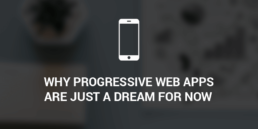
Why Progressive Web Apps are just a dream for now?
First things first. What is a PWA? “PWA” Stands for ” Progressive Web App “, and it is supposed to allow developers to create mobile websites that behave and perform super-fast…like an app. Aaron Gustafson, who works on web standards at Microsoft, explains: “They are a better way to enable a website to work more like a native installed app.” They are called progressive because they are expected to get progressively better depending on the technology in the device. But are they?
The technology is around for some years now, two more specific. In 2016 Google announced PWAs at the Google I/O developer conference. Moreover, they brought as an example The Washington Post which has a PWA website. You just had to search their website, click it and save the web page to your homescreen. And voila, PWA. Theoretically everything sound great, put practically, well…stick with us and see!
Couldn’t you save pages to your homescreen before?
Of course you could. Then what’s the deal with this, you might ask. They are also supposed to have offline functionality, just like an app. And the structure is completely different from a mobile website. A Progressive Web App has an “app shell”, which is the main frame in which you put your content. The app shell is composed from HTML, CSS and JavaScript so it provides a fast loading time, but just for the first time, after that it will be immediately cached.
Inside the shell, there will be the content, which, in most cases, is dynamic. This “app shell” architecture, as Google calls it, should improve the speed a user is served the required data. If you want to give it a shot and get the code better explained you can click here.
Didn’t Google have AMP Project?
Apparently, PWA is the consequence of AMP. A better developed way of creating mobile websites. But Google focuses more on AMP and they appear to forget about web apps. There are more advantages in having an accelerated mobile page than a progressive app. Very important aspects such as google first indexing of AMP Pages and the fast loading time are just a plus for AMP. If you don’t believe it, just check The Washington Post’s website on your mobile. We’ve tested it on the latest technologies in both Android and iOS and it is remarkably slower than expected! It should get progressively better as the mobiles have better capabilities, don’t they?!
They might work for small web apps, such as a weather app as advertised in the tutorial mentioned above. There is not a tone of content to load. But who, in today’s world uses an entire website/web app just to display the weather. There are apps and numerous widgets with far more content integrated and many other capabilities that behave way better than a PWA.
Are there any real advantages?
No. Having a progressive web app has no advantages so far. Especially when you have the alternative such as AMP or simple HTML Sites. Having your website built as a PWA is unimaginably expensive – one can reach up to $20.000 depending on the complexity. And there is absolutely no reason for investing. The loading time is not considerably better (it can be even worse), the cost is groundbreaking high and your website will not be indexed by Google differently.
Verdict Time!
As for the time being we believe that this technology is far from perfect. If there was any moment when you thought you should have a PWA you should reconsider. The best comparison with real life is this: It’s like there is a party in your neighbourhood and you are the first to arrive. Not even the DJ (Google) is there! And really, there is no reason for him to come in the near future. It appears Google is on the same page with us by not investing more into it. We’ll stick around and see what happens next. Until then, there are other parties you can join! Check out our HTML Mobile Templates, Google AMP Templates, Mobile WordPress Themes and PhoneGap & Cordova Apps.
Tell us, what do you think about Progressive Web Apps. Are they worth it or did it fail before it started?
